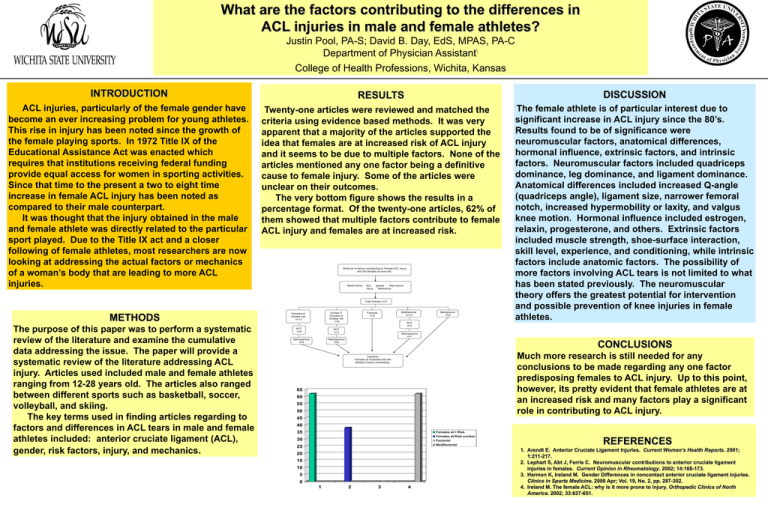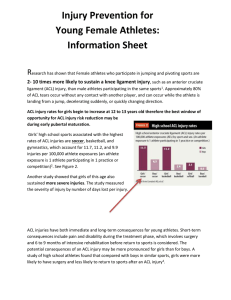pa0605015.ppt
advertisement

What are the factors contributing to the differences in ACL injuries in male and female athletes? Justin Pool, PA-S; David B. Day, EdS, MPAS, PA-C \ Department of Physician Assistant College of Health Professions, Wichita, Kansas INTRODUCTION RESULTS DISCUSSION ACL injuries, particularly of the female gender have become an ever increasing problem for young athletes. This rise in injury has been noted since the growth of the female playing sports. In 1972 Title IX of the Educational Assistance Act was enacted which requires that institutions receiving federal funding provide equal access for women in sporting activities. Since that time to the present a two to eight time increase in female ACL injury has been noted as compared to their male counterpart. It was thought that the injury obtained in the male and female athlete was directly related to the particular sport played. Due to the Title IX act and a closer following of female athletes, most researchers are now looking at addressing the actual factors or mechanics of a woman’s body that are leading to more ACL injuries. Twenty-one articles were reviewed and matched the criteria using evidence based methods. It was very apparent that a majority of the articles supported the idea that females are at increased risk of ACL injury and it seems to be due to multiple factors. None of the articles mentioned any one factor being a definitive cause to female injury. Some of the articles were unclear on their outcomes. The very bottom figure shows the results in a percentage format. Of the twenty-one articles, 62% of them showed that multiple factors contribute to female ACL injury and females are at increased risk. The female athlete is of particular interest due to significant increase in ACL injury since the 80’s. Results found to be of significance were neuromuscular factors, anatomical differences, hormonal influence, extrinsic factors, and intrinsic factors. Neuromuscular factors included quadriceps dominance, leg dominance, and ligament dominance. Anatomical differences included increased Q-angle (quadriceps angle), ligament size, narrower femoral notch, increased hypermobility or laxity, and valgus knee motion. Hormonal influence included estrogen, relaxin, progesterone, and others. Extrinsic factors included muscle strength, shoe-surface interaction, skill level, experience, and conditioning, while intrinsic factors include anatomic factors. The possibility of more factors involving ACL tears is not limited to what has been stated previously. The neuromuscular theory offers the greatest potential for intervention and possible prevention of knee injuries in female athletes. What are to factors contributing to Female ACL Injury and are females at more risk. MeSH terms: ACL Injury gender Risk factors Mechanics Total Articles n=21 METHODS The purpose of this paper was to perform a systematic review of the literature and examine the cumulative data addressing the issue. The paper will provide a systematic review of the literature addressing ACL injury. Articles used included male and female athletes ranging from 12-28 years old. The articles also ranged between different sports such as basketball, soccer, volleyball, and skiing. The key terms used in finding articles regarding to factors and differences in ACL tears in male and female athletes included: anterior cruciate ligament (ACL), gender, risk factors, injury, and mechanics. Unclear if Females at Greater risk n=8 Females at Greater risk n=13 RCT n=6 Multifactorial n=13 Factorial n=0 RCT n=3 RCT n=3 Retrospective n=4 Background n=6 Retrospective n=7 Retrospective n=5 CONCLUSIONS Much more research is still needed for any conclusions to be made regarding any one factor predisposing females to ACL injury. Up to this point, however, its pretty evident that female athletes are at an increased risk and many factors play a significant role in contributing to ACL injury. Outcome: Females at Increased risk with Multiple Factors contributing. 65 60 55 50 45 40 35 Females at > Risk Females at Risk unclear Factorial Multifactorial 30 25 20 15 10 5 0 1 2 3 4 REFERENCES 1. Arendt E. Anterior Cruciate Ligament Injuries. Current Women’s Health Reports. 2001; 1:211-217. 2. Lephart S, Abt J, Ferris C. Neuromuscular contributions to anterior cruciate ligament injuries in females. Current Opinion in Rheumatology. 2002; 14:168-173. 3. Harmon K, Ireland M. Gender Differences in noncontact anterior cruciate ligament injuries. Clinics in Sports Medicine. 2000 Apr; Vol. 19, No. 2, pp. 287-302. 4. Ireland M. The female ACL: why is it more prone to injury. Orthopedic Clinics of North America. 2002; 33:637-651.





